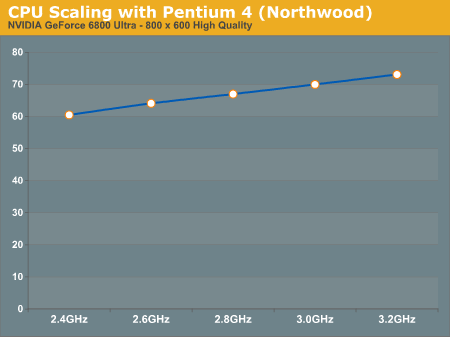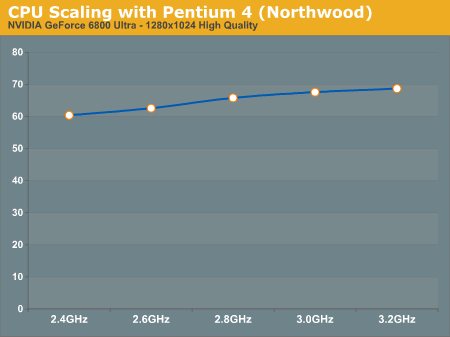How does CPU Speed Impact Graphics Performance?
For the most part, we ultimately make our purchasing decisions based on price. If we have $200 to spend on a processor, it doesn't matter how fast an Extreme Edition runs our apps and games unless it sells for $200. It's the price point that determines what our options are, and then we look at the best performer at that price point to make our final decision. But when upgrading, it's sometimes difficult to know when to upgrade various components - especially a CPU.
If you have a 2.4GHz Pentium 4, is it worth it to upgrade to a 3.4GHz P4 in order to get greater performance in Doom 3? Or is your 2.4GHz P4 paired up just fine with a NVIDIA 6800GT? These next set of graphs are designed to help you see the type of CPU scaling you can expect out of a high end card like the GeForce 6800 Ultra, or a slower card like the Radeon 9800 Pro.
The graphs below are frame rate vs. clock speed graphs, taken using a Pentium 4 C and varying the clock speed on a single platform. Once again it's the curve of the graph that you want to look at; the steeper the slope of the curve is, the more benefit you'll get from having a faster CPU. The flatter the curve is, the less benefit you'll get from having a faster CPU.
Although we're only showing two cards here, you can extrapolate performance of faster and/or slower cards pretty easily. Using our Doom 3 Graphics Guide you should know what cards are faster or slower than the two we're representing here; then just remember that a faster card will have a steeper (more CPU dependent) curve, while a slower card will have a flatter (less CPU dependent curve).
Also keep in mind that the scaling will be relatively similar for both AMD and Intel platforms; we chose to stick with only a single platform here in the interest of time as well as keeping these pages simple.
First up, we have the 6800 Ultra at 800x600:

Here we have a decently steep curve, probably the steepest it will get since we're dealing with one of the fastest GPUs at a relatively low resolution. The move from a 2.4GHz to a 3.2GHz processor resulted in a 21% increase in performance, considering that this was because of a 33% increase in clock speed it is safe to say that at lower resolutions the more money you put into a faster CPU, the higher your Doom 3 performance will be on a 6800 Ultra.

At higher resolutions the burden shifts to the GPU as is evident by the change in the slope of the curve. Now we have a distinctly more flat curve, with only a 13% difference between the fastest and the slowest CPUs - it's not insignificant, but definitely not huge.

Looking at the 9800 Pro at 800x600 we see a curve that closely resembles the 6800 Ultra's curve at 1280x1024, once again with a 13% gain seen from the 2.4GHz processor to the 3.2GHz part.
Although the rest of our CPU tests use the 6800 Ultra, the standings and degrees of performance improvement will apply to other graphics cards as well. As we've just seen, at 1280x1024 the GeForce 6800 Ultra scales much like a Radeon 9800 Pro at 800x600 - keep that in mind as we compare CPUs under id's latest and most impressive 3D game to date.










59 Comments
View All Comments
michael2k - Wednesday, August 4, 2004 - link
Heh, what about frames/$ graphs?Da3dalus - Wednesday, August 4, 2004 - link
Lovely graphs, *pats my Athlon 64 3200+ while waiting for Doom 3*Another week for Doom 3 to hit our european shelves, damnit I hate waiting for something you americans already have :-/
elfy6x - Wednesday, August 4, 2004 - link
I have a dual Opteron 246 setup, with 1Gb of ram, and a Radeon 9700 Pro. I'm not really a gamer, but I gave Doom 3 a shot, and it utilizes both of my CPU's when I play. I have nothing else running when I play the game. It doesn't tax both CPU's to 100% but one CPU fluctuates between 40-50% while the other one bounces around 10-20%. So something is processing two threads. Just my observation. :)PotatoMAN - Wednesday, August 4, 2004 - link
I second the idea of benching memory and video memory at AT for doom week. I have a 3200+ A64 and I am wondering if I am starving it more with a 9800 pro (128) or with my 512mb of RAM. Thanks AT for being awesome!Gooberslot - Wednesday, August 4, 2004 - link
I bet a 1-1.2ghz P3 or Athlon would cut it for a minimum. Just go back and look at the old benchmarks of the P4 1.5ghz on here. Only in Quake3 was the P4 on top. In UT the P4 actually tied with the P3 1ghz. Pathetic. Stating minimum requirements based on those old Williamete P4's is very misleading. Perhaps the real minimum cpu requirements should have been 1.2ghz P3 or Athlon, 1.5ghz P4, or 2.4ghz Celeron. :)matman326 - Wednesday, August 4, 2004 - link
Man I always knew that an athlon 64 system was powerfull but a 180 dollar proc. beating Intels Extremly Expensive 1000 dollar proc is just mind blowing. So much for the Netburst design kicking butt.AtaStrumf - Wednesday, August 4, 2004 - link
If you could find some time, I'd like to see a comparison between 128 and 256 MB R9800Pro, and 512 RAM and 1024 MB RAM. Basicly how much of a difference do video and system RAM make.at80eighty - Wednesday, August 4, 2004 - link
dammit! looks like im gonna celebrate Christmas with a loan..grrrr... : )WooDaddy - Wednesday, August 4, 2004 - link
Two words:AMD ROX!!!
I've been an AMD user since the 386 days and even had a NexGen processor (pre-pentium, K5). Never went Intel, never will (maybe)...
Thatsright,
Naw.. The charts don't lie. But to be fair, let's wait for the Intel-funded people (aka Tom's (blow)hardware) to put up their benchmarks. 10 bucks says they'll make all kinds of excuses to why Intel procs aren't fast enough.
Regs - Wednesday, August 4, 2004 - link
Wow. Good info. Dual channel offers nothing. And the socket 939 2.2 Ghz CPU offers nothing over my 3000 A64 which costs 200 dollars less. Given that if you play on higher resolutions.